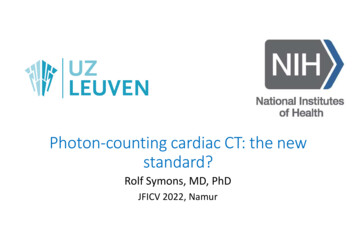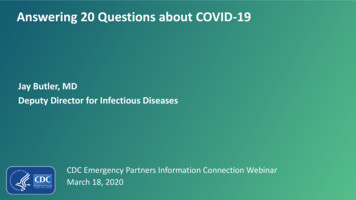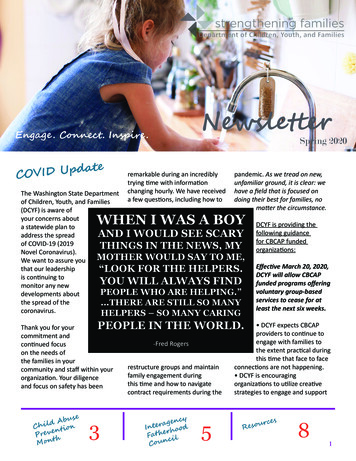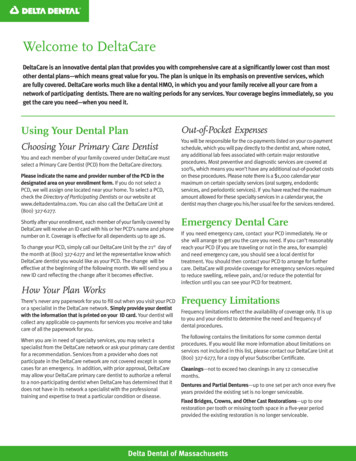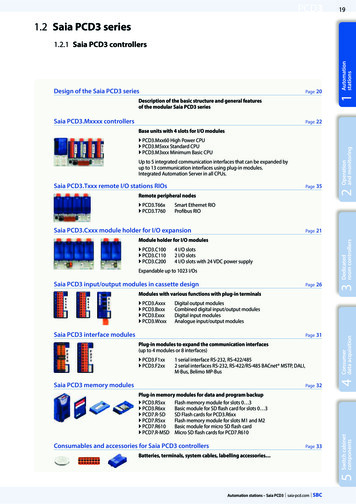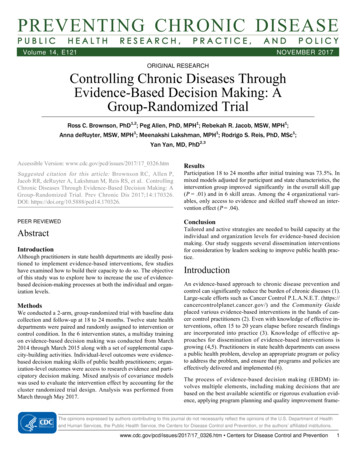
Transcription
PREVENTING CHRONIC DISEASEPUBLICHEALTHRESEARCH,PRACTICE,Volume 14, E121ANDPOLICYNOVEMBER 2017ORIGINAL RESEARCHControlling Chronic Diseases ThroughEvidence-Based Decision Making: AGroup-Randomized TrialRoss C. Brownson, PhD1,2; Peg Allen, PhD, MPH1; Rebekah R. Jacob, MSW, MPH1;Anna deRuyter, MSW, MPH1; Meenakshi Lakshman, MPH1; Rodrigo S. Reis, PhD, MSc1;Yan Yan, MD, PhD2,3Accessible Version: www.cdc.gov/pcd/issues/2017/17 0326.htmResultsSuggested citation for this article: Brownson RC, Allen P,Jacob RR, deRuyter A, Lakshman M, Reis RS, et al. ControllingChronic Diseases Through Evidence-Based Decision Making: AGroup-Randomized Trial. Prev Chronic Dis 2017;14:170326.DOI: https://doi.org/10.5888/pcd14.170326.Participation 18 to 24 months after initial training was 73.5%. Inmixed models adjusted for participant and state characteristics, theintervention group improved significantly in the overall skill gap(P .01) and in 6 skill areas. Among the 4 organizational variables, only access to evidence and skilled staff showed an intervention effect (P .04).PEER REVIEWEDConclusionAbstractTailored and active strategies are needed to build capacity at theindividual and organization levels for evidence-based decisionmaking. Our study suggests several dissemination interventionsfor consideration by leaders seeking to improve public health practice.IntroductionAlthough practitioners in state health departments are ideally positioned to implement evidence-based interventions, few studieshave examined how to build their capacity to do so. The objectiveof this study was to explore how to increase the use of evidencebased decision-making processes at both the individual and organization levels.MethodsWe conducted a 2-arm, group-randomized trial with baseline datacollection and follow-up at 18 to 24 months. Twelve state healthdepartments were paired and randomly assigned to intervention orcontrol condition. In the 6 intervention states, a multiday trainingon evidence-based decision making was conducted from March2014 through March 2015 along with a set of supplemental capacity-building activities. Individual-level outcomes were evidencebased decision making skills of public health practitioners; organization-level outcomes were access to research evidence and participatory decision making. Mixed analysis of covariance modelswas used to evaluate the intervention effect by accounting for thecluster randomized trial design. Analysis was performed fromMarch through May 2017.IntroductionAn evidence-based approach to chronic disease prevention andcontrol can significantly reduce the burden of chronic diseases (1).Large-scale efforts such as Cancer Control P.L.A.N.E.T. (https://cancercontrolplanet.cancer.gov/) and the Community Guideplaced various evidence-based interventions in the hands of cancer control practitioners (2). Even with knowledge of effective interventions, often 15 to 20 years elapse before research findingsare incorporated into practice (3). Knowledge of effective approaches for dissemination of evidence-based interventions isgrowing (4,5). Practitioners in state health departments can assessa public health problem, develop an appropriate program or policyto address the problem, and ensure that programs and policies areeffectively delivered and implemented (6).The process of evidence-based decision making (EBDM) involves multiple elements, including making decisions that arebased on the best available scientific or rigorous evaluation evidence, applying program planning and quality improvement frame-The opinions expressed by authors contributing to this journal do not necessarily reflect the opinions of the U.S. Department of Healthand Human Services, the Public Health Service, the Centers for Disease Control and Prevention, or the authors’ affiliated institutions.www.cdc.gov/pcd/issues/2017/17 0326.htm Centers for Disease Control and Prevention1
PREVENTING CHRONIC DISEASEVOLUME 14, E121PUBLIC HEALTH RESEARCH, PRACTICE, AND POLICYNOVEMBER 2017works, engaging the community in assessment and decision making, adapting and implementing evidence-based interventions forspecific populations or settings, and conducting sound evaluation(7). To select and implement evidence-based interventions in diverse populations and settings, advanced knowledge and skill isneeded in key processes (eg, adaptation of interventions, evaluation) (8).Previous research with state health agencies showed that althoughlevels of awareness of EBDM is high, implementation of evidence-based interventions varies widely and is limited in manystates (9). Similarly, another study found that although cancer control practitioners showed a strong preference for programs withproven effectiveness, fewer than half of respondents in that study(48%) had ever used resources on evidence-based interventions(10). A national survey of state practitioners in chronic diseasecontrol found that only 20% used evidence-based interventions often in their work (11). Nonetheless, staff members in state publichealth agencies recognize the need for capacity building to support implementation of effective practices (10).Putting evidence to use in public health settings requires sufficient capacity — the availability of resources, structures, andworkforce to deliver the preventive dose of an evidence-based intervention (12). Capacity is a determinant of performance; that is,greater capacity is linked with greater effect on public health(13,14). Success in implementing EBDM in public health settingsis achieved by building the skills of individuals (eg, their ability tocarry out a program evaluation) and organizations (eg, achieving aclimate and culture that supports innovation and evidence-basedapproaches) (12). These 2 skills are interrelated in that individualsshape organizations and organizations support the development ofindividuals (15).tensive EBDM training, and 3 states that had no logical pairmatch. State exclusion criteria are detailed elsewhere (16). The remaining 33 states were organized into tertiles according to statepopulation size. Two pairs from each state population tertile wereselected in 3 rounds of staggered selection and enrollment. Eachround consisted of 1 state randomly selected from each of 2 tertiles and matched with the nearest population-sized state withinthe tertile. Six state health department’s chronic disease prevention units (hereinafter called states) were selected via a simple randomization method by our data analyst (R.R.J.) and then pairmatched with the state closest in population size, to decreasebetween-state variability, for a total of 6 pairs (6 interventionstates and 6 control states, 1 each per pair). We then invited thestates to participate by contacting the chronic disease director ineach state health department. Two states declined to participate,and we selected the state with the nearest population in the tertileto replace that state to retain our total of 12. After pairing and obtaining consent from the lead chronic disease official, whom wedesignated as the state-level representative, the 2 states in eachpair were randomly assigned to the intervention arm or controlarm. There was no blinding. Enrollment of state pairs, data collection, and intervention trainings were staggered for scheduling feasibility. Enrollment of states took place from September 2013through May 2014. The trial was registered withClinicalTrials.gov (NCT01978054) (17). The study was approvedby the Washington University in St. Louis Institutional ReviewBoard (no. 201111105).To date, little research has addressed the most effective approaches for building capacity for EBDM in state public healthagencies seeking to address chronic disease prevention and control. The objective of this study was to test whether providingtraining and other support to state health departments increased theuse of EBDM processes to prevent chronic diseases at both the individual level (eg, reducing skill gaps) and the organization level(eg, increasing participatory decision making).MethodsWe conducted a 2-arm, group-randomized trial consisting of an intervention arm and a control arm (Figure). We assessed 50 statesand the District of Columbia for eligibility. We excluded 3 stateswith the lowest burden of cancer and overall chronic disease, 3states with the lowest capacity for EBDM, 2 states with thehighest capacity for EBDM, 7 states that had already received exThe opinions expressed by authors contributing to this journal do not necessarily reflect the opinions of the U.S. Department of Health and Human Services,the Public Health Service, the Centers for Disease Control and Prevention, or the authors’ affiliated institutions.2Centers for Disease Control and Prevention www.cdc.gov/pcd/issues/2017/17 0326.htm
PREVENTING CHRONIC DISEASEVOLUME 14, E121PUBLIC HEALTH RESEARCH, PRACTICE, AND POLICYNOVEMBER 2017strategies intended to build an organizational culture of EBDM,improve staff access to research evidence, share information, andbuild evaluation capacity (Appendix Table 1). Follow-up conference calls with intervention states provided technical assistanceand supplemental activity planning and updates.Control states. Control states identified participants for data collection and received a list of EBDM resources, web links, andstate-specific baseline and post-intervention findings. They received no training, and all control state participants were asked tocomplete an online baseline survey before their paired state’s multiday training.ParticipantsStudy participants were 2 groups of chronic disease control practitioners at the state and local level, an intervention group and acontrol group. These were people who directed and implementedpopulation-based intervention programs in government agenciesor in community-based coalitions. Participants were directly involved in delivering programs, setting priorities, or allocating resources for programs related to chronic disease risk factors orscreening. Examples were the director of a comprehensive chronic disease program for the state or a leader in a state or regionalchronic disease control coalition.Figure. Flow diagram of the study of evidence-based decision makingconducted in 12 states, 2014–2016 (CONSORT diagram).InterventionIntervention states. The intervention began with a 3.5-day trainingin EBDM conducted onsite at each of the 6 intervention statesbetween March 2014 and March 2015. Training details are described elsewhere (18). The lead official responsible for chronicdisease control in each state assisted the team in recruiting training participants from among their staffs and sometimes includedstaff members from state or local partnering organizations. A totalof 222 staff members attended a multiday EBDM course in 1 ofthe 6 intervention states. All intervention state participants wereasked to complete an online baseline survey before the multidaytraining. Each intervention state received a report on its baselinesurvey results for planning purposes and selected supplemental capacity-building activities, typically brief trainings or managementThe intervention arm comprised 2 groups: a primary group and asecondary group. The primary group in each intervention state wasmade up of staff members who attended the EBDM course; mostworked in state health departments and a few were from state orlocal partnering organizations. The secondary group in each intervention state, none of whom attended the EBDM course, wasmade up of chronic disease staff members and partnering staffmembers from each state health department, local health departments, universities, and coalitions (collaborators). Collaboratorswere surveyed because they were expected to apply EBDM intheir organizations for control of chronic diseases as funded orguided by the state. Inclusion of collaborators also helped thestudy team meet sample size requirements. All participants wereaged 20 years or older and able to take an online survey in English. Across the entire sample, most participants worked either inchronic disease risk reduction or chronic disease screening.Measures, data collection, and statistical analysisMeasures in the 65-item online Qualtrics Version January2014–November 2016 (Qualtrics) survey were informed by a literature review (13) and earlier research by the study team (16,19).Measures, described in detail elsewhere (16,20,21), were testedwith cognitive response methods and test–retest reliability (16).Survey questions assessed individual-level skills (eg, adapting interventions, action planning, communicating to policy audiences)The opinions expressed by authors contributing to this journal do not necessarily reflect the opinions of the U.S. Department of Health and Human Services,the Public Health Service, the Centers for Disease Control and Prevention, or the authors’ affiliated institutions.www.cdc.gov/pcd/issues/2017/17 0326.htm Centers for Disease Control and Prevention3
PREVENTING CHRONIC DISEASEVOLUME 14, E121PUBLIC HEALTH RESEARCH, PRACTICE, AND POLICYNOVEMBER 2017and organizational-level capacities (eg, access to evidence, program evaluation, perceived supervisory expectations) (AppendixTable 2). Survey participants were asked to rate on a 11-pointLikert scale the perceived importance and perceived availability of10 EBDM skills.Online self-report surveys were administered, by state, at 2 pointsat staggered times: 1) a baseline survey conducted from January2014 through December 2014 and 2) a post-intervention surveyconducted from October 2015 through November 2016, 18 to 24months after the state pair’s EBDM training. The study team followed up each returned post-survey email invitation to determinewhether the participant had left the agency or just had a new emailaddress and recorded reasons for declining among those who declined the post-survey by telephone or email.The unit of analysis was individual staff members, with individuals from all 12 clusters (states) who completed both surveys included in analyses. We calculated baseline intra-cluster correlations for the dependent variables using standard methods to assessneed for mixed modeling, but we elected to conduct mixed modeling as a conservative approach regardless of result. One-stagemixed analysis of covariance (ANCOVA) models were fitted byusing PROC MIXED (SAS Inc) with state as a random effect toaccount for clustering by state (22). The between–within methodwas used to calculate denominator degrees of freedom for thefixed effect instead of the SAS default containment method, because it is more appropriate for unbalanced study designs. SASversion 9.4 was used for descriptive analyses and mixed ANCOVA modeling, and SPSS version 24 (IBM Corp) was used toclean and recode data and create calculated variables. Covariateswere included in final ANCOVA models when the unadjusted effect size was attenuated by 10% or more on the basis of additionof a particular covariate to the model (23). Sex was included in alladjusted models as required in studies funded by the National Institutes of Health. All tests of significance were 2-sided, includingthe χ 2 tests and independent samples t tests used to comparebaseline participant characteristics and scores. The sample sizecalculation of the study is described elsewhere (16).The primary individual-level outcomes were gaps in EBDM skillsamong public health practitioners and their use of research evidence for job tasks. The primary organization-level outcomes wereaccess to research evidence and the presence of a staff withEBDM skills, supervisory expectations for EBDM use, evaluation,and work unit participatory decision making as assessed throughindividuals’ perceptions. The main analyses compared data on theprimary intervention arm participants with data on control participants; we also compared data on secondary intervention arm participants and control participants.We calculated gaps in the 10 EBDM skill scores by subtracting thescore in perceived availability from the score in perceived importance for each individual for each skill. Higher gap scores indicatelarger gaps. A summary score for gaps in skills was calculated foreach individual by summing the values for gaps in scores for the10 EBDM skills. A summary frequency of use of research evidence for job tasks was the calculated mean of the 6 job task responses.We used items from a 7-point Likert scale (1 “strongly disagree”and 7 “strongly agree”) to conduct exploratory factor analysiswith orthogonal rotation to create individual scores for 5 factors:1) access to research evidence and resources (4 items), 2) evaluation capacity (3 items); 3) supervisory expectations (3 items), 4)participatory decision making (3 items), and 5) agency leadershipsupport (3 items) as in a previous national survey with state healthdepartment public health practitioners (21). By definition, thefactor scores had a mean of zero and were normally distributed.One or more organization behavior items were left blank by 34 ofthe 567 survey participants (6.0%); these participants were excluded from factor score creation and mixed ANCOVA modeling.ResultsAt baseline, 1,237 of the 1,508 invited public health practitionerscompleted the online survey (82.0% response, 83.6% for the 6 intervention states, 80.2% for controls). At follow-up, 909 (73.5%)of baseline participants completed the post-intervention survey,with a median of 73 participants per state (mean, 75.8; standarddeviation [SD], 10.6). Loss to survey follow-up was primarily dueto staff turnover. Of the 222 people assigned to the primary intervention arm who attended the EBDM training, 148 (66.7%) completed both baseline and post-intervention surveys (Table 1); ofthe 439 secondary intervention arm participants, 342 (77.9%)completed both surveys, and of the 580 control participants, 419(72.2%) completed both surveys. Overall, most baseline surveyparticipants were women (80.6%), and 64.3% had at least a master’s degree in any field. At baseline, primary intervention participants differed significantly from control participants in severalcharacteristics: for example, the percentage working in state healthdepartments, age, and the percentage holding a master’s degree ordoctorate in public health. The number of primary interventionarm participants varied by state from 18 to 32, and the number ofcontrol participants varied by state from 65 to 72.The largest EBDM skill gaps at baseline were for adapting interventions, economic evaluation, and communicating research topolicy makers (Table 2). Mean scores at baseline did not differThe opinions expressed by authors contributing to this journal do not necessarily reflect the opinions of the U.S. Department of Health and Human Services,the Public Health Service, the Centers for Disease Control and Prevention, or the authors’ affiliated institutions.4Centers for Disease Control and Prevention www.cdc.gov/pcd/issues/2017/17 0326.htm
PREVENTING CHRONIC DISEASEVOLUME 14, E121PUBLIC HEALTH RESEARCH, PRACTICE, AND POLICYNOVEMBER 2017significantly between groups, except for 3 skills: adapting interventions (t 2.49, P .01), economic evaluation (t 2.10, P .04), and community assessment (t 2.01, P .04). Baseline intracluster correlations were low in all the states (ranging from .001to .018), indicating low correlation of responses within states.The primary intervention group significantly improved in theoverall skill gap (P .01) and in 6 skill areas compared with thecontrol group (Table 3). In the comparison of secondary intervention arm participants and control participants, intervention effectson the 10 skill gaps were attenuated and no longer significant.Sex was included in all adjusted mixed ANCOVA models and didnot affect sizes of intervention effects. Sex was not associated withgaps in skills, except that men were more likely than women tohave a smaller gap in qualitative evaluation when we adjusted forother characteristics (β 0.55, t 2.45, P .03). Having atleast a master’s degree in any field was associated with increaseduse of research evidence for job tasks (β 0.18, t 2.93, P .01)and with increased supervisory expectations of EBDM use (β 0.24, t 2.46, P .03). Being in a leadership position was associated with increased participatory decision making, compared withthe reference group of program managers (β 0.27, t 2.22, P .03). Other participant and state characteristics did not affect themodels. Among the 4 organizational capacity dependent variables,only access to evidence and skilled staff showed an interventioneffect (t 2.73, P .04). In the comparison of secondary intervention arm participants and control participants, no intervention effects were significant for organization-level outcomes.DiscussionOur study is among the first to test the effects of strategies to increase the use of EBDM processes among public health practitioners engaged in controlling chronic diseases. We sought to reducethe gap between the generation of evidence and its application inpractice settings, which can be viewed as “leakage in the dissemination pipeline” from discovery to application (24). In large part,this leakage relates to lack of individual and organizational capacity to practice EBDM (12).Our 12-state study showed improvements in individual-level capacity in several skill areas, although for the content area with thelargest baseline gap (economic evaluation), we saw no improvement. Although deficits in EBDM competencies among state-levelpractitioners appear to be narrowing over time (25), interventionslike ours probably can narrow the gap more rapidly. The skillareas of interest were derived from a systematic process (26) andare essential for making use of many online tools and toolkits forchronic disease control (eg, the Community Guide, Cancer Control P.L.A.N.E.T.).In a systematic review of dissemination studies of cancer prevention in community settings (5), the role of organizational factors inthe uptake of evidence-based interventions was scarcely examined.We sought to increase the variety of organization-level variables.Our interventions did not result in significant improvements inmeasures of organizational capacity. The exception was for the 4item factor on access to evidence and skilled staff. Organizationalchange is difficult and requires long-term commitment. It is possible that the interventions in our study were not intensive enoughto result in measureable organizational change in some variables.Several studies have shown a high rate of turnover in state publichealth agencies (27). This ever-changing workforce may make itdifficult to develop and maintain an organizational climate andculture supportive of EBDM.Limitations of this study should be noted. It was difficult to gatherobjective data on practitioner or agency performance. Althoughdata were well-tested psychometrically, we relied on self-reported(perceived) data on individual-level and organization-level outcomes. We assessed no direct chronic disease outcomes (eg, doesgreater use of research by practitioners lead to better chronic disease outcomes?), yet a substantial body of literature shows that thevariables we measured on EBDM lead to better performance (13).Performance over time was probably improving in our controlgroup given that many programs funded by the Centers for Disease Control and Prevention now require grantees to implementEBDM. Although it is established that individuals influence organizations and the reverse (12), our finding that only 1 of 4 organization-level outcomes was affected by our intervention suggests that more intensive interventions and longer time periodsmay be needed to change an organization’s climate and culture.Given that our intervention group included only 6 states, our findings may not be generalizable to all states.This study should be considered first-generation research and canbe viewed in the context of the growing literature on dissemination and implementation research (12). Several topics deserve future consideration among practitioners and researchers. First, moretailored, active approaches are warranted. It is unclear whether ourstudy approach was intensive enough to sustain positive changes.In addition, larger effects for subgroups (eg, master’sdegree–trained individuals) suggest approaches may need to beadapted for various staff categories. The skill sets for health department staff members may differ from those needed among partners outside of a public health agency. Second, there is a need forbetter measures of EBDM. One of the greatest needs amongchronic disease control practitioners is how to better assess organizational capacity (28). Most existing measures focus on ultimateoutcomes, such as change in health status. Most existing measuresof capacity have not been tested adequately for reliability and pre-The opinions expressed by authors contributing to this journal do not necessarily reflect the opinions of the U.S. Department of Health and Human Services,the Public Health Service, the Centers for Disease Control and Prevention, or the authors’ affiliated institutions.www.cdc.gov/pcd/issues/2017/17 0326.htm Centers for Disease Control and Prevention5
PREVENTING CHRONIC DISEASEVOLUME 14, E121PUBLIC HEALTH RESEARCH, PRACTICE, AND POLICYNOVEMBER 2017dictive validity (29). Third, capacity building needs to occur in thecontext of staff turnover. The rate of turnover among participantsin our study was substantial, suggesting that frequent exposure toEBDM processes may be needed as new staff members are hiredand trained. Fourth, the lack of change in some skill areas (eg,economic evaluation) may call for more intensive skill building orseeking out partners (eg, university staff) to help with more complex content areas. Fifth, more attention is needed on driving organizational change. Changing organizational culture and climateto an environment supportive of EBDM takes time and concertedeffort (30). The intervention activities in our study may not havebeen intensive enough to foster measureable change in organizations, especially considering the heterogeneity in organizations.To control chronic disease at a population level, EBDM requires acomplex set of individual skills and organizational capacity. Ourfindings suggest several dissemination interventions that should beconsidered by practitioners as they seek to apply EBDM in theiragencies to ultimately benefit the populations they serve.AcknowledgmentsThis work was supported by the National Cancer Institute of theNational Institutes of Health (grant no. R01CA160327 and no.5R25CA171994 to Washington University in St Louis). We thankour partners in this study: the National Association of ChronicDisease Directors and leaders and staff members in the 12 statehealth departments in the study. We also thank Leslie Best, CarolBrownson, Carsten Baumann, Dr Elizabeth Baker, Dr AnjaliDeshpande, Dr Maureen Dobbins, Dr Ellen Jones, Dr Jon Kerner,and Dr Katherine Stamatakis, who served as trainers or consultants to the study. We also thank Dr Jenine Harris and Dr TimothyMcBride for conceptual guidance and help with survey development.Author InformationCorresponding Author: Ross C. Brownson, PhD, PreventionResearch Center in St. Louis, Brown School, WashingtonUniversity in St. Louis, One Brookings Dr, Campus Box 1196, St.Louis, MO 63130. Telephone: 314-935-0114. Email:rbrownson@wustl.edu.Author Affiliations: 1Prevention Research Center in St. Louis,Brown School, Washington University in St. Louis, St. Louis,Missouri. 2 Department of Surgery, Division of Public HealthSciences, and Alvin J. Siteman Cancer Center, WashingtonUniversity School of Medicine, Washington University in St.Louis, St. Louis, Missouri. 3Division of Biostatistics, WashingtonUniversity School of Medicine, Washington University in St.Louis, St. Louis, Missouri.References1. Remington P, Brownson R, Wegner M, editors. Chronicdisease epidemiology and control. 4th edition. Washington(DC): American Public Health Association; 2016.2. Briss PA, Brownson RC, Fielding JE, Zaza S. Developing andusing the Guide to Community Preventive Services : lessonslearned about evidence-based public health. Annu Rev PublicHealth 2004;25(1):281–302.3. Lenfant C. Shattuck lecture — clinical research to clinicalpractice — lost in translation? N Engl J Med 2003;349(9):868–74.4. Chaudoir SR, Dugan AG, Barr CH. Measuring factorsaffecting implementation of health innovations: a systematicreview of structural, organizational, provider, patient, andinnovation level measures. Implement Sci 2013;8(1):22.5. Rabin BA, Glasgow RE, Kerner JF, Klump MP, BrownsonRC. Dissemination and implementation research oncommunity-based cancer prevention: a systematic review. AmJ Prev Med 2010;38(4):443–56.6. Institute of Medicine. The future of the public’s health in the21st century. Washington (DC): National Academies Press;2003.7. Brownson RC, Baker EA, Deshpande AD, Gillespie KN.Evidence-based public health. 3rd edition. New York (NY):Oxford University Press; 2018.8. Chambers DA, Norton WE. The Adaptome: advancing thescience of intervention adaptation. Am J Prev Med 2016;51(4,Suppl 2):S124–31.9. Brownson RC, Ballew P, Dieffenderfer B, Haire-Joshu D,Heath GW, Kreuter MW, et al. Evidence-based interventionsto promote physical activity: what contributes to disseminationby state health departments. Am J Prev Med 2007;33(1,Suppl):S66–73, quiz S74–8.10. Hannon PA, Fernandez ME, Williams RS, Mullen PD,Escoffery C, Kreuter MW, et al. Cancer control planners’perceptions and use of evidence-based programs. J PublicHealth Manag Pract 2010;16(3):E1–8.11. National Association of Chronic Disease Directors. NACDDall member survey. Atlanta (GA): NACDD; 2010. .12. Brownson RC, Fielding JE, Green LW. Building capacity forevidence-based public health: reconciling the pulls of practicewith the push of research. Annu Rev Public Health .
by the Washington University in St. Louis Institutional Review Board (no. 201111105). PREVENTING CHRONIC DISEASE VOLUME 14, E121 PUBLIC HEALTH RESEARCH, PRACTICE, AND POLICY NOVEMBER 2017 The opinions expressed by authors contributing to this journal do not necessarily reflect the opinions of the U.S. Department of Health and Human Services,

